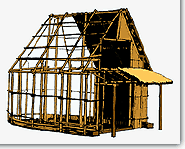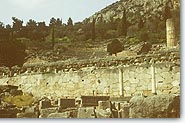









       | |
  | |
|
Before the |  |
The materials that were used in masonry, to replace the bricks, were mainly local limestone or porous stone and later on different varieties of marble. Its best examples come from public buildings -often fortifications- as in the temples the sculptured decoration and their architectural design were more important than the masonry itself. The stone blocks supported one another only with their weight, that is without the use of binding material. However, the masons achieved a perfect binding of the edges of the blocks. Binding mortar started to be widely used during the Hellenistic period.
However, in order to avoid the horizontal shifting of blocks, since seismic activity was always intense in the Greek areas, metallic joints (dowels and clamps) of different shapes were used. They were usually made of iron and rarely of bronze, and were placed in special rectangular cuttings in stone, were fixed with lead and hence they ensured the cohesion of the courses. This contributed to the destruction of many ancient buildings during the Middle Ages, with the purpose of extracting these metal elements.
 The ancient Greeks invented and used various masonry methods and according to each period or building type demonstrated their special preference for some of these. During Archaic times the polygonal masonry system was widely spread, a specific version of which was called Lesbian, because of the best surviving examples at the acropolis of Lesbos. In fact Lesbian masonry was in use along the coastline of Asia Minor and in parts of the islands and the mainland of Greece, during the 7th and most of the
The ancient Greeks invented and used various masonry methods and according to each period or building type demonstrated their special preference for some of these. During Archaic times the polygonal masonry system was widely spread, a specific version of which was called Lesbian, because of the best surviving examples at the acropolis of Lesbos. In fact Lesbian masonry was in use along the coastline of Asia Minor and in parts of the islands and the mainland of Greece, during the 7th and most of the
|
| |
|
Note: Click on picture for short description. | |